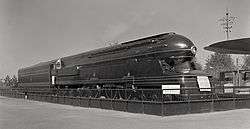6-4-4-6

A 6-4-4-6 steam locomotive, in the Whyte notation for describing locomotive wheel arrangements, is one with six leading wheels, two sets of four driving wheels, and six trailing wheels.
Other equivalent classifications are:
UIC classification: 3BB3 (also known as German classification and Italian classification)
French classification: 3223
Turkish classification: 2525
Swiss classification: 2/5+2/5 up to the early 1920s, later 4/10
Only one was produced, the Pennsylvania Railroad's sole class S1 of 1939. It was a duplex locomotive, the longest and heaviest rigid frame reciprocating steam locomotive ever built, and is referred to as the Pennsylvania Type. This experimental locomotive was exhibited at the 1939 New York World's Fair, and was afterward placed in limited service between Chicago, Illinois, and Crestline, Ohio. The locomotive was too large to work elsewhere in the system. Pennsylvania Railroad executives hoped that the locomotive could haul 1,000 tons at 100 miles per hour, but this goal was not reached. It was capable of very high speeds however, although no documentary evidence has so far surfaced to add credence to stories of record-breaking performance.